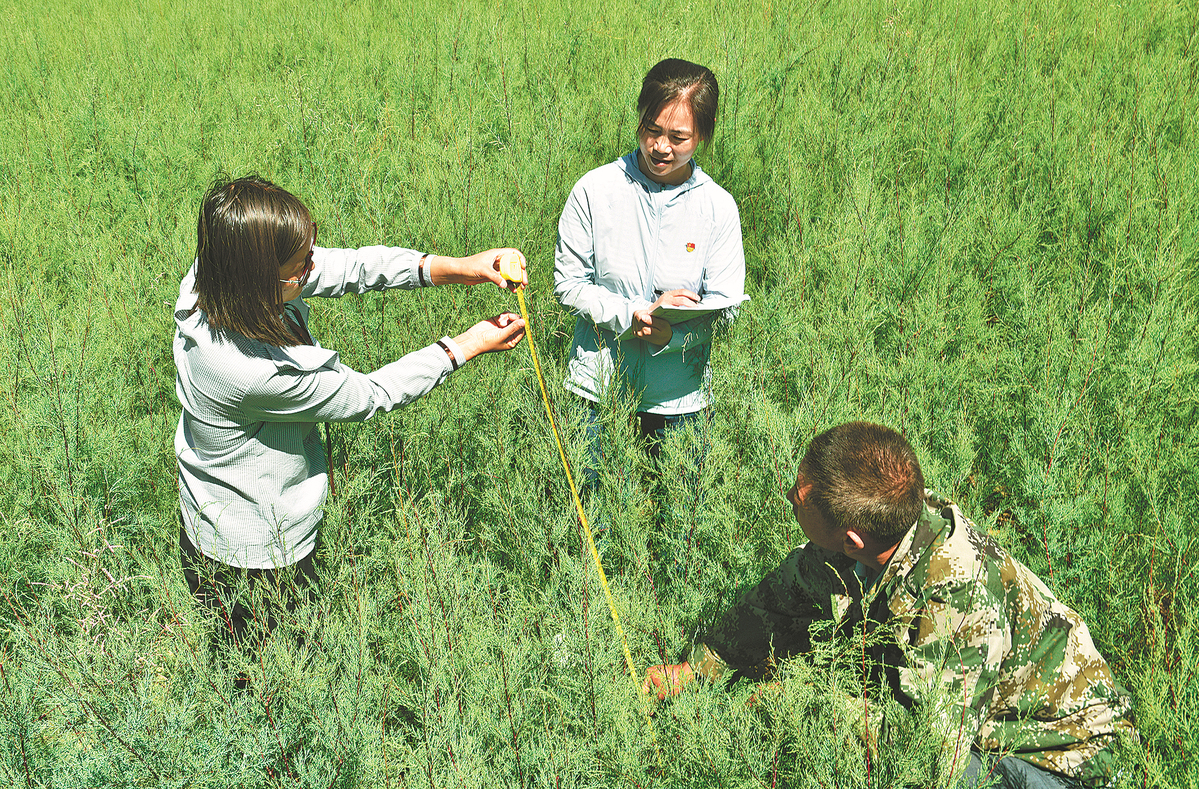Northwestern desert oasis holding back the sands


Greening of Gansu's Minqin county stabilizes environment, provides source of income
Jiang Liling returned to her village in Gansu province, which is bordered by the Badain Jaran and the Tengger deserts on three sides, to devote herself to turning the yellow to green.
When she was a teenager, many villagers moved their families elsewhere, unable to bear the harsh environment.
"I once asked my father when we would move, but he said where else can we go, this is our home," Jiang recalled.
The 43-year-old is now a civil servant at the county's office for transforming farmland into forests and grassland.
In order to find a way to save her village, Jiang enrolled at a technical school to study forestry. After graduation, she joined the campaign to prevent desertification, and in the 24 years since then, her life has been closely linked to desert control and development.
In 2019, she was given the "National Advanced Individual with Outstanding Contribution to Ecological Construction" award.
"In the past, desertification forced residents to leave their homes. Now, we are recapturing lost land through the restoration of vegetation," Jiang said, adding that Minqin in Wuwei city has now become a place of hope with blue skies, green land and clear water.
By the end of last year, the county had human-made forests covering 153,333 hectares, and forest coverage had increased from 3 percent in the 1950s to 18.28 percent, thanks to generations of dedicated sand control efforts.
Jiang began by growing shrubs on sandy land. As a result of long-term exposure to the pesticides she was using, she began to suffer from allergies. There were suggestions that she change jobs, but she was determined to keep going.
"The reason I had come back here to work was to make my village green. I really didn't want to see it suffering from sandstorms," she said.
No matter what difficulties she encountered, Jiang never forgot why she was there.

At least twice a year, she and her colleagues spend about a month in the desert overseeing afforestation work on site. Every day, they cover about 20 kilometers on foot.
"We eat simply. At night, we have to be careful to keep our tents from being blown over," she said.
Sometimes, she remains at the test center in the desert waiting for a sandstorm to gather firsthand data on new materials and new technologies used in sand prevention and control.
Once, she and her colleagues were forced to walk for nearly five hours to get out of the desert because part of the way back had been covered by sand after a storm.
In 2007, Gansu's governance plan for the Shiyang River basin was officially approved and implemented. In Minqin, which is located downstream of the river, reforesting marginal farmland became an important task.
Jiang not only helped prepare the feasibility study report and implementation plan, but also worked to change the minds of people unwilling to give their farmland to the project.
Through patience and a willingness to help, she eventually gained their support.
In Xiqu town, which is located on the edge of the desert, some of the farmland was not included in the government project. Through her efforts, Jiang was able to ensure that 186.66 hectares of arable land in danger of desertification were properly treated, and the villagers received subsidies of 3.44 million yuan ($481,470).
She also taught villagers to graft cistanche salsa, or broomrape, a plant used in traditional Chinese medicine, onto saxaul trees. They set up a center on 306.66 hectares of land from which they harvest 100 metric tons of the plant a year, earning villagers some 2 million yuan.
Today, the environment in Minqin is better, and residents are much better off.
In Jiang's village, which is called Lianfeng, villagers are benefiting from growing greenhouse vegetables such as peppers, cucumbers and tomatoes.
"Minqin is an oasis that prevents the two deserts from becoming one. As an important barrier protecting the environment in northwestern China, it must have a better future," Jiang said.
Ma Aibin contributed to this story.
- China publishes Han-Tibetan version of major dictionary
- People advised to guard against dengue fever, diarrhea and other diseases
- Exploring China's Xixia Imperial Tombs with Yuanxi
- SCO foreign ministers council meeting to be held in Tianjin
- Foreign officials praise Chinese gardening culture for promoting harmony
- Tianzhou 9 cargo craft transported to launch site





































